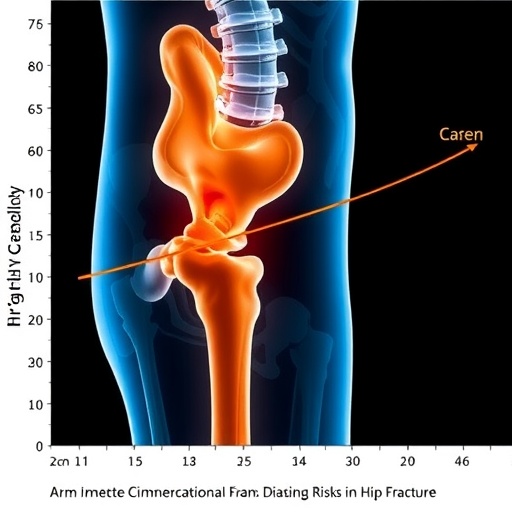In a groundbreaking study poised to transform geriatric care, researchers have illuminated a startling correlation between arm circumference and mortality rates in older adults who suffer from hip fractures. This research, conducted by an esteemed team comprised of Ceolin, Termini, Sella, and others, has been published in the prestigious journal Eur Geriatr Med. The findings present a compelling case for the inclusion of a simple anthropometric measurement in assessing the health risks faced by the elderly, particularly in the wake of major orthopedic injuries.
Hip fractures are a significant public health issue, with an incidence that has been rising in many parts of the world due to an aging population. The ramifications of such injuries extend beyond the immediate physical trauma; they carry a heightened risk of mortality that is often underestimated. Traditionally, various risk factors have been scrutinized, including age, sex, comorbid conditions, and nutritional status. However, this latest study proposes that arm circumference, an easily measurable parameter, could serve as a critical indicator of health outcomes following a hip fracture.
Researchers meticulously examined a cohort of older adults who had sustained hip fractures. Through a series of analyses, they discovered that patients with a smaller arm circumference exhibited a significantly elevated risk of mortality within the subsequent twelve months following their injury. This finding challenges existing paradigms surrounding the assessment of fragility and recovery prospects for seniors recovering from such events.
The study utilized a robust methodology, leveraging a diverse sample and a longitudinal design to capture data over an extended period. The results were illuminating, suggesting that arm circumference may not only be a reflection of nutritional status but also of overall muscle mass, strength, and resilience—factors that are critical for recovery in the elderly. This aspect of the research underscores the need for a more nuanced understanding of physical measurements and their implications for health.
Moreover, the implications of such a straightforward assessment tool cannot be overstated. Arm circumference measurements can be performed quickly and inexpensively, making it accessible in various healthcare settings, from hospitals to outpatient clinics. This ease of use positions it as a feasible metric for health professionals who often grapple with the complexities of geriatric assessments.
Exploring the mechanisms behind the correlation, the researchers speculate that smaller arm circumference may indicate lower muscle mass and, consequently, diminished physical reserve. This reduced reserve could hinder recovery from surgery and rehabilitation post-fracture, leading to further complications. The interplay between muscle mass, mobility, and mortality underscores a vital area for future research, emphasizing the need to understand how strength can serve as a buffer against the frailty often experienced in older age.
The significance of these findings cannot be ignored. As healthcare systems worldwide adapt to an increasing geriatric population, the ability to identify at-risk patients swiftly could have profound implications for public health strategies. Empowering healthcare providers with this knowledge enables targeted interventions, potentially reducing the incidence of post-fracture complications and improving quality of life for older adults.
As the study gains attention, it invites further inquiry into additional anthropometric measurements that could serve as predictors of health outcomes. While arm circumference is a promising starting point, the exploration of other easy-to-measure indicators may yield even richer insights into the multifaceted challenges faced by older adults.
Policy-makers should take note of these findings. With healthcare systems under strain, identifying efficient, cost-effective methods for assessing elderly patients could lead to better resource allocation and support systems tailored to their needs. Investing in preventive measures and personalized care based on such data could ultimately improve survival rates and recovery trajectories among seniors.
Beyond the immediate implications for individuals who have experienced a hip fracture, this research contributes to a growing body of evidence advocating for a paradigm shift in geriatric care. As the field evolves, it will be essential for practitioners to consider a holistic view of patient health, one that integrates various physical metrics into comprehensive assessments.
In conclusion, the study led by Ceolin and colleagues serves as a clarion call to both the medical community and the public. It highlights a relatively simple measurement—arm circumference—capable of providing vital insights into mortality risk in older adults post-hip fracture. With further validation and acceptance, such metrics could lead to improved clinical practices and, ultimately, saved lives. The challenge now lies in disseminating this knowledge across healthcare systems to ensure that elderly patients receive the attentive care they deserve in their most vulnerable moments.
As we await broader acceptance and application of these findings, one must reflect on the potential for anthropometric data to revolutionize how the healthcare community approaches aging. Could arm circumference be the key to unlocking better health outcomes for millions? Only time and further research will tell, but this study paves the way for a more nuanced understanding of mortality predictors in our aging population.
Subject of Research: The correlation between arm circumference and mortality rates in older adults with hip fractures.
Article Title: Arm circumference predicts 12-month mortality in older adults with hip fracture.
Article References:
Ceolin, C., Termini, G., Sella, S. et al. Arm circumference predicts 12-month mortality in older adults with hip fracture.
Eur Geriatr Med (2025). https://doi.org/10.1007/s41999-025-01364-z
Image Credits: AI Generated
DOI: https://doi.org/10.1007/s41999-025-01364-z
Keywords: arm circumference, mortality, hip fracture, older adults, geriatric care, health metrics.
Tags: aging population and orthopedic injuriesanthropometric measurements in healtharm circumference and mortality riskCeolin Termini Sella research findingsgeriatric care and health assessmentship fracture outcomes in elderlymortality rates in older adultsnutrition and hip fracture recoverypublic health implications of hip fracturesrisk factors for hip fracture complicationssimple measurements for health evaluationstudy on arm circumference and health





